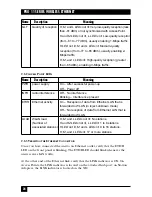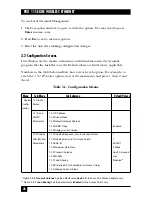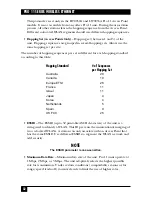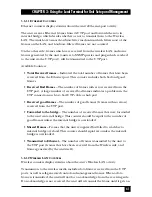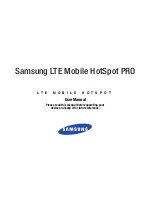
33
CHAPTER 3: Using the Local Terminal for Unit Setup and Management
•
Transmit Antenna –
Which antennas are used for transmission. During
reception, a Pro 11 unit dynamically selects the antenna where reception is
optimal. In contrast, the unit selects the antenna from which it will transmit
before transmission. It usually uses the antenna last used for successful
transmission. In models with external antennas, sometimes only a single
antenna is used. In this case, Transmit Antenna should be configured to
transmit only from that single antenna. Similarly, models using a booster
(transmit power amplifier with a 250-mW output) or an LNA (low-noise
receive amplifier) use only a single antenna for transmission. There are three
possibilities for configuration: 1) use two antennas, 2) use Antenna no. 1 only,
or 3)use Antenna no. 2 only.
•
Mobility –
Pro 11 stations optimize their roaming algorithms according to the
Mobility parameter. For example, a stationary station is more tolerant of bad
propagation conditions. It assumes that this is a temporary situation and is not
caused by the station changing position. Initiating a roaming procedure in
such a case would be counter-productive. In general, wireless stations can be
used in one of three mobility modes:
High (Mobility).
Type
2
for stations that may move at speeds of over 30 km
per hour.
Medium (Mobility).
Type
1
for stations that may move at speeds of over 10
km per hour, but not over 30 km per hour.
Low (Mobility).
Type
0
for stations that will not move at speeds of over 10
km per hour. Stationary is the default value, and in almost all cases this is
the best choice.
•
Load Sharing –
Type
1
to enable Load Sharing. When installing a Wireless
LAN network in a high-traffic environment, you can increase the aggregate
throughput by installing multiple Access Points to create co-located cells. Load
Sharing allows the wireless stations to distribute themselves evenly among the
Access Points to best divide the load between the Access Points.
NOTE
When working in Load Sharing mode, both the Access Points and the
units should be configured to Load Sharing Enabled.
•
Preferred AP MAC (Ethernet) address of the preferred Access Point
— You
can configure a station to prefer a specific Access Point unit. When the station
powers up, it will associate with the preferred Access Point even if the signal
from that Access Point is lower than the signal from other Access Points. The
station will roam to another Access Point only if it stops receiving beacons
from the preferred Access Point.
Содержание LW0050A
Страница 2: ......






